Crete – most Germans think of nothing more than a holiday island in the Mediterranean when they hear the name. Nowadays, it is little-known that on the 20th of May 1941 the German Wehrmacht started an invasion and occupied the island for four years. German soldiers – especially the special forces of paratroopers and mountain infantry – committed barbarous massacres among the civilian population and took vengeance for the Cretan resistance movement Andartiko who opposed the German attack by burning down entire villages. We have been following the tracks of history and interviewed survivors on the occasion of an anniversary week of an anarchist squat in Heraklion. Nothing is forgotten or forgiven!
An anarchist week in Heraklion
The journey into the past was triggered by an anarchist week in Heraklion. The Evagelismos Squat in 18 Theotokopoulou Street in Heraklion celebrated its 13th anniversary from the 22nd until the 28th of June 2015. The anarchist squat is located in the old town of Heraklion only two streets from the harbour and not far away from the central Platia Venizelou, the Lions Square. The square is named after the Lions' Fountain which originates from the times of the Venetian occupation. It began after the Fourth Crusade in 1204 and ended after a 21 years siege of Heraklion in 1669. Even though the actual reason why the fountain has no water are the corrosion damages to the Lions of Saint Mark, the fountain is nevertheless a symbol for the water shortage which is perceptible on the whole island. Recently, the Nazi party Golden Dawn announced to open an office near the squat. In the night before the official opening ceremony, anarchists broke down the office and took the front door with them. They also convinced the shopkeepers that having Nazis in the neighbourhood might be bad for business. All this has led to an early end of Golden Dawn in the old town of Heraklion. Antifascist politics against Golden Dawn in Crete are all together much more successful than in the rest of Greece.
Anniversary week from the 22nd to the 28th of June 2015 to celebrate the 13th year of the Evagelismos Squats in Heraklion
The anniversary week had a distinctly European flavour. Anarchists from Sweden, France, Italy and Germany participated in numerous workshops and discussions. There has been a lively exchange of ideas about the commonalities and differences of local struggles. Contacts to Greek comrades have been established and intensified. The spectrum of subjects ranged from ecology (resistance against wind turbines near Rethymno on Crete, against the gold mines in Skouries in Northern Greece, against the high speed train in the Susa Valley, against the barrage of Sivens and the major airport in Notre-Dame-des-Landes in France), international networking, refugee policy, workers' self-management, repression and digital self-defence. Several DIY workshops and concerts have been organised; the 1st LGBTQI+ Pride of Crete took place on the 27th of June; and on the 28th of June, at the eve of the bank closings and the introduction of capital transactions controls in the forefront of the financial referendum on the 5th of July, a big banquet on the barred street in front of the squat with more than 200 anarchists.
1st LGBTQI+ Pride demonstration on the 27th of June 2015 in Heraklion, Crete
Graffiti based upon a banner of the 4th of December 1944, the beginning of the Greek civil war:
Όταν ο λαός βρίσκεται μπροστά στον κίνδυνο της τυραννίας διαλέγει ή τις αλυσίδες ή τα όπλα
Confronted with tyranny people will either choose the chains or the arms
Exploring the vestiges of the past
Far away from the hustle and bustle of lively Heraklion, we meet Kostas in a mountain village in the back country of Rethymno on the north coast of Crete. His uncle was a member of the resistance movement against the Germans and he died 10 years ago. We ask Kostas to tell us stories about the time of the occupation. He tells us that the Germans took the best houses in his village to live in. The next day, he returns with his mother and translates for us what she wants to tell us. One day, soldiers from the Wehrmacht came to her village. They threatened the inhabitants at gun point to move outside of the village and dig their own graves. The old woman makes a semi-circular movement with an imaginary submachine gun. No translation is needed to grasp the massacre.
Nevertheless, both emphasize the spirit of resistance of the Cretans. Kostas tells us about his mother's aunt who was ill at the time of the German occupation and as a consequence needed to eat meat. When German soldiers came and saw the meat they wanted to take it away. But his aunt was an adamantine woman who attacked and drove the Germans away: “I am ill. I don't need vegetables, I need meat!” Kostas says that this is typical for the people on this island: “If someone wants to steal their rabbit then they'll attack the thief no matter if he's armed or not. Maybe they're nuts but that's how they are.”
They tell us the story of the German plane on the airfield of Maleme, which we've had already heard from the pope in the monastery of Preveli on the south coast of Crete. The Wehrmacht tried to transport looted goods with a German plane from Maleme which was unable to start. An old man went to the Germans and asked if there was something in the plane that did not belong to them. Only after they removed the cross they had taken from the monastry of Preveli, which is supposed to contain a splint from the cross of Jesus, could the plane take off.
German military cemetery on “Hill 107” in Maleme, Crete. Lots of Nazi soldiers have been killed by Allied forces from this point
The religiously charged narrative about the cross is apparently quite powerful on Crete, as several people told us the story. It also shows that the clergy is perceived by many as part of the resistance against the occupation. This is in accordance with the monuments at many monasteries which have been erected by Britons, New Zealanders and Australians to thank the monks who have hidden, sheltered and fed their soldiers. The churchly resistance has a long tradition within the Cretan struggle for freedom against foreign occupiers. Kostas' mother tells us rather casually a story of her family who fought at the end of the 19th century against the Turkish occupation, which started in 1648 and ended in 1898 which ended with the Greco-Turkish War.
Commemoration of the resistance of the monks of the Preveli Monastery on the south coast of Crete against the German occupation
The “Paratroopers Monument” is a well-known Nazi memorial near Chania. It has been erected in 1941 by the Nazi occupiers and displays an eagle striking down with a swastika in its claws and a stone relief with the outline of “Greater Germany”. It served as a venue for old and new Nazi comrades even in the time after the Second World War. While the owners of the property have been fighting for years for the removal of the Nazi memorial, which has also been attacked in 2005 during an antifascist action, Nazis talked about a restoration of the marred eyesore. Uwe Irrgeher from Kuchen/Fils near Stuttgart initiated an online petition for the conservation of the Nazi memorial which has been signed by 11.419 revisionists, among others by the German Nazi Bursche (member of a fascist student fraternity) Armin Allmendinger and the Swiss Hammerskin Adrian Segessenmann.
Commemorative plaques for Cretans killed by German soldiers
The website of the revisionist for the conservation of the Nazi memorial is registered on the name of a psychoanalyst from Düsseldorf, Walter Dmoch. Roman Krasch from Rosenfeld in Baden-Württemberg is listed as administrative contact. Krasch attracted attention in the late 1990s with terrorist ambitions as he obtained weapons and explosives. Until the end of 2012, he was a member of the Reservists Comradship of the German Bundeswehr in Steinlach-Wiesatz.
Commemorative plaques to remember the German Wehrmacht's atrocities and the Cretan resistance
On many streets in Crete, one can find small shrines for the dead, mostly killed in car accidents at these sites. On the mountainous street from Chania, on the northern coast, to Paleochora, on the southern coast, we discovered this other shrine instead, in a curve just before Floria, it's inscription telling another story:
“In remembrance of the four brothers buried here, killed by the barbaric Germans on the 28th of August 1944: Emmanuel K. Despotaki, 27 years. Spiros K. Despotaki, 23 years. Charalampos K. Despotaki, 17 years. Anastasis K. Despostaki, 17 years.“
Memorial shrine near Floria for the Greek victims of the Germans and memorial stone in Floria for the Gebirgsjäger (mountain infantry) killed in battle
But right in the middle of Floria, on it's main street, one can find a fascist monument for the German “Gebirgsjäger“ (mountain infantry). After the Wehrmacht started it's invasion of Crete on the 20th of May, Wehrmacht units were held here on the 23rd of May for two long days, 25 German soldiers were killed. The Cretan resistance in Floria allowed Allied troops to reach the south coast and flee from there. The Germans were taken by surprise, not expecting resistance from the civilian population of Crete against their invasion. Their illusion of a “German-friendly population“ was as much a misconception as their underestimation of the number of Allied troops. Additionally, the British had broken the encryption of the German Enigma with their “Ultra“-programme and thus knew the time and place of the planned invasion beforehand.
Forced memorial for the destruction of Kandanos on the 3rd of June 1941, memorial for the murdered citizens and only compensation
The revenge of the Nazis was extremely cruel. The commanding General Kurt Student gave an order on May 31st, 1941:
“The troops did already help itself in self-defence as much as possible during the combat operations. Now the time has come to follow up all such cases in a planned way, to retaliate and to hold tribunals that will serve as deterrent in the future. Possibilities for retaliatory measures: Executions, extortions, burning of villages (beforehand confiscation of all cash money, which will go to the families of soldiers), extermination of the male population of whole areas. Under these circumstances, this will be the concern of the troops and not of regular courts. These are not eligible for beasts and murderers.“
German secondary virtues: extermination, inhumanity, obedience and brutality
This order was carried out to the word. Paratroopers murdered dozens of inhabitants of Kondomari on June 2nd, 1941 and mountain infantry killed hundreds in Kandanos on the 3rd of June and burned the village to the ground. The German war correspondent Franz Peter Weixler, as a witness of the massacre of Kondomari, testified (PDF) in court against Hermann Göring. None of the soldiers involved in the massacres was sentenced for his crimes, not even General Student was prosecuted for his criminal order. In 1941, the Wehrmacht in Crete destroyed the towns and villages of Chania, Kandanos and Skines, in 1943 Mournies, Myrtos, Gdochia, Kalikrates, Koustogeraka, Livadas, Monis and Viannos and in 1944 Kouneni, Sokara, Ano Meros, Gerakari, Kria Vryssi, Vrysses, Damasta, Anogia, Faleriana, Floria, Limni, Lousakies, Enneachorion, Paläokastro, Gougourthoni, Potamido, Syrikari, Voulgaro, Skouloudiana, Kalathenes, Koxare, Miamous, Panagia and Vaphes. All in all, the Greek War Crimes Office named 42 villages and towns where mass executions and massacres of the Wehrmacht took place.
Killing of hostages by German paratroopers in Kondomari on June 2nd,1941
On the 26nd of May 1956, the head of the Royal Greek War Crimes Office in Athens asked the German judiciary to prosecute 87 identified war criminals charged with “the murder of more than 3.000 inhabitants of the island of Crete, the terrorising, torture, deportations and arrests of Greek civilians“. He got an answer from the head of the central bureau of the state of North Rhine Westphalia for the handling of war crimes in Greece. According to him, the investigations revealed that 39 of the accused couldn't be found because their addresses were missing, 7 might not be in Germany, 12 already died, the cases against 13 others were transfered elsewhere or merged with other cases and two of the accused were already charged with similar crimes and thus could not be prosecuted again. “Regarding the remaining 12, the investigations did not reveal a probable cause justifying a public arraignment.“ (Source: Ulrich Kadelbach, Schatten ohne Mann, Die deutsche Besetzung Kretas 1941-1945).
The Wehrmacht Crimes in Viannos
Αριστομένης Συγγελάκης (Aristomenis Siggelakis)
We have an appointment with Aristomenis around noon of the 27th of June 2015 in a kafenion at a busy street crossing in Eastern Heraklion. People sitting next to us argue heatedly about the referendum on the austerity measures demanded by the creditor institutions, that prime minister Tsipras has annouced the night before. Aristomenis emphasises repeatedly that he is glad that we have asked him for an interview. He readily tells us about the massacre that the Wehrmacht has committed in his home village Viannos in 1943. As president of the organisation of the survivors he is used to giving interviews about the subject. He offers us to arrange interviews with other survivors directly in Viannos. We accept his offer and make two more interviews the following day. Aristomenis tells us:
“My name is Singelakis Aristomenis. My father was called Aristomenis. I am elected as president of the Union of the Survivors of Viannos and as second mayor of Viannos. Viannos and the area around is known since Minoan time. Since then we have had a lot of fights and suffering. But from 1941 to 1947 it was the lowest point.
Immediately after the occupation of the island of Crete in May 1941, a big Andartes (Guerilla) group was formed in the Viannos area. If you go to the area, you'll see the landscape, it's a mountaneaous area, there's a large forest. It was the highest number of resistance fighters in Crete. This made the German Army scared, they didn't dare to go up the mountains. In Omalos plain, the British dropped supplies from airplanes.
A small group of Andartes attacked an outpost in the village of Simi and took it out. Two of the three German soldiers stationed there were killed. The third one was absent at the time of the attack. Müller, he was the military commander of the German Army in Heraklion, gave a violent order. One group of German soldiers came to Viannos, another group came from the seaside and went to Simi. The way to Simi is a gorge. Today there is a monument, it's easy to spot it. The first soldiers to arrive took hostages, twelve people, among them the pope Mateos Yayadakis. They had the hostages in front of them when they went to Simi. They had the order to execute all the people of Simi and also burn it.
But the Andartes had set up an ambush in four places at the entrance of the village. The total number of the Andartes was 47 people. The German Army was large, 80 to 100 people. At 10am they entered Simi and had the hostages in front of them. Before the Andartes attacked, they said in Greek: ‘Run for your life!’ After they started running, the Germans started to fire. The German soldiers were from Special Forces of the Third Reich. So the fight started at 10am and lasted until 7pm. After 7pm, a lot of German soldiers were dead. I can not tell you the number because I don't want to tell lies. The Andartes also took 14 German soldiers as hostages, they took them up the mountains with them. During the night, local villagers who were asked by the Andartes to do so carried the dead German soldiers back to Viannos with donkeys. The battle of Simi happened on September 12th, 1943. The first attack had been on the 10th of September. And after that, General Müller gave the order that within the villages, every man should be executed immediately. And outside the villages the order was to execute everyone, without consideration of age or sex. For that reason, Müller has been called the ‘Butcher of Viannos’.
During the next three days, on the 14th, the 15th, and the 16th of September, all villages in the area have been surrounded. The German soldiers invaded the houses and took everyone, men, women, kids, old people. During this period of three days, more than 400 villagers were killed. From the villages of Viannos area and from the western part of Ierapetra area. All in all, 461 people have been killed from the area.”
Monument near Kato Simi and Memorial of Amiras in remembrance of the events of September 1943
“I will now tell you two stories. The first one is the story of my own village, Amiras.
On the morning of the 14th of September 1943, they started with propaganda. The propaganda said: They wouldn't do anything bad, everyone should return to the village, even if they were in forbidden areas. But if the men wouldn't come back, they would destroy their houses and the kill their families. So on the morning of the 14th of September, at 6 o'clock in the morning the village was surrounded by the army. Until 10 o'clock, 120 people had been gathered by the Germans at the square of the church. After 10am they took 30 men and moved them away, with the Army on the front, back, left and right, 30 civilians in the middle. And they have been executed about 500 metres away from the church. And all the area was surrounded by heavy machinery because they were afraid of the Andartes. They took groups of 30 people away. This is how the executions happened: they shot them in the head from a close range, people had no heads or brains any more. Some were shot from further away.
In the third round, when they executed 90 people, an Austrian soldier refused to shoot because he felt pity. So the other Germans took that Austrian guy and he was also executed. On that day, 114 people had been executed at Amiras. After 4 or 5 o'clock they left to a house nearby and celebrated. After 5 o'clock they left and then another drama started.
The dead bodies had to be carried to the cementary, which is 500 metres away, but very high up the mountain. They dind't have donkeys any more and there were only small kids and women. And they had to carry 114 dead bodies. They tried to put 5-6 dead bodies without heads and brains on a donkey they found, but it was very difficult and they couldn't carry the bodies. So instead, they opened large pits in the ground at the execution spot and in every pit they put 15 to 20 bodies. But the ground is very rocky and it was hard to dig and night was coming. And people were finding there own relatives amongst the bodies. And the dogs were very close, they were attracted by the smell of blood. The people were afraid of the dogs, so they dug very shallow holes, because the ground was difficult. They put a very small amount of earth on top because it was so difficult. And then at night the dogs got the dead bodies out and ate them. On the next day they cleaned the bodies and brought the remains to the village graveyard, in a mass grave.
Now I'll tell my personal story.
My name is Aristomenis Singellakis and my father is Aristomenis Singellakis. This is because my mother was pregnant in the second month when they killed my father. He was killed together with four brothers of his and my grandfather. At the execution there were also two more of my father's brothers. So besides my father they killed seven of my relatives. The eighth brother was at this time between Greece and Albania, he was then brought to the Middle East and had been lost for 4 years, without any contact. He was at Al Alamein, it was very isolated. After four years, my grandmother and my mother, with one surviving kid, did the ceremonies we do after the funeral, because they thought him dead. So when he returned after four and a half years, my mother and sister ran away and were shouting: ‘A ghost! Touch me, am I alive?’
So this is the personal story of my family.”
Γεώργιος Ιωάννου Δασκαλάκης (Georgios Ioannou Daskalakis)
We meet Georgios around noon on the 28th of June 2015 in Amiras. He tells us in touching words his shattering story. He has been interviewed for the Crete film, too. Georgios tells us:
“In Amiras, 114 people were killed, everyone who was older than 18 years old. This is the spot where my grandfather died. It was in 1943, on a Sunday. First, a unit of German soldiers went to the village of Simi. But when they came to Simi, a group of Andartes attacked them and killed about 40-50 Germans. The villagers carried the dead Germans with donkeys to Viannos.
On Monday the Germans went to the village Agios Vasilios. They said that if people came back to their houses, they wouldn't hurt anyone.
On Tuesday they came to Amiras. At 10 o'clock in the morning, the village was surrounded. They arrested many villagers, only very few managed to escape. There were also villagers outside in the mountains, but everyone inside the village was collected. About 140-150 people had been arrested. They said: ‘If we find someone outside, we're going to kill his brothers and sisters and mothers and destroy his house.‘
I was only 14 years old. My father was hiding in the village with my brother who was 19 years old and with other people also. My father told me: ‘Come, my child, and go to the village of Vachos with your mother.‘ They sent us to a sheperd's hut to buy some milk, so we wouldn't be in the village. At this moment, there were no Germans about. We went at night and slept outside the village.
The next morning we went to the main road and waited for my grandfather to come. The Germans surrounded the village of Vachos. We heard the gunfire and heard shouting and people crying. And I was in the middle of nowhere and didn't know what to do. After the massacre I ran to the village, there were no Germans anymore. I saw two piles of dead bodies. And I lost my mind and ran away crying.
When I came back here to Amiras, it was night and the Germans were gone. My mother was crying. I couldn't eat or drink. I went down to the execution place, to find my father. It was two or three at night. I went to the first pile of dead bodies, but I couldn't find my fater. Then I went to the second pile, and I found my father. Also my two grandfathers and my uncles. I went to the seaside to find my brother. My brother survived because he was hiding. The village was destroyed.
There was one German who refused to shoot the villagers, so the Germans shot him, too.
I have nothing with the young Germans. But we demand reparations as a moral compensation.”
Στέλιος Μαθιουδάκης (Stelios Mathioudakis) and Ιωάννης Βερυκοκάκης (Ioannis Verikokakis)
On the 28th of June in the late afternoon we meet Stelois and Ioannis at the Kafenion in Amiras. They are both skeptical and want to know first who we are and why we'd like to hear their story. “Are there no old people to ask in Germany?“ Yes, of course there are, but we don't want to reproduce the perpetrator's story. Down in Sidonia village another survivor stated: “It's good I've met you. It made me realize that not all Germans are cold hearted.“ We tell Stelios and Ioannis about our antifacist motivation and more and more people gather at the Kafenion to listen to their story. Ioannis tells us:
“In 1941, the Italians came. In 1943, after the Italians left, the Germans arrived. One day, two of us killed two Germans in Kato Simi. The Germans knew that our people were up there. After that, a unit of Germans came and they killed a Greek who went by the same name as a leader of the Andartes. Then they arrested a pope and a tax collector. On the way to Kato Simi the Germans were attacked. It was Sunday, the 12th of September 1943. It was a small gorge where the Andartes attacked.
On Monday, the Germans took the mules and donkeys from Amiras and brought them to Viannos. On Tuesday, between 9.30 and 10am, 250 of them started in Viannos. I was 14 years old back then. We went with three more children and goats and sheep on the “king's path“, that's how we called the goat's path. As we were walking from the church to Amiras, about 100 Germans came down the path. They came with machine guns. We met the Germans and they were very quiet, they didn't even greet us. Three Germans arrested us and one of them told us: “Go over there to the church!“ That's were they had rounded up the other villagers.
The Germans brought us and about 30 other people to the graveyard, were we were supposed to be shot. But the Germans found that place unsuitable and brought us all the way down to another church, there are many churches around here. They gathered around 150 people, the primary school was just next to it. The Germans set up two machine guns. One ran away and the Germans shot a burst of fire after him. But he managed to escape.
One neighbor, who was an American citizen, was asked for his passport. The American asked how he should get his passport. The highest ranking German officer wanted to come along to the house of the American to get his and his wife's passports. The mayor of the village told us to go with him and get the Germans his passport. But he also told us not to come back, as everyone would be killed here.
Just in front of our eyes they killed Manolis Grisbolakis, he was disabled. And Stavros Daskalakis, he was blind. He was killed while he fed his chickens.”
The massacre of September 14th, 1943 is still very present at Amiras
“There were about 140 to 145 people gathered. They brought all of them down to the beach at Arvi. As they were walking down, 50 Germans went with them. Down at Arvi the Germans set up a radio station. They asked by radio: “We got 145 people, should we shoot them now?“ Then a special unit with skulls came, about 40 soldiers, they came from Ierapetra. They separated 30 people and led them away to another place. That's where they shot them. Then they took another 30. But to a different place, so the second group wouldn't see the first one. Then they took 40, and at the 4th time another 40.
Some survived, because they were only wounded. Of the 140 people, about 20 survived. Then the Germans came back to the village and murdered more people. Some of the dead were eaten by pigs, because the villagers couldn't get close enough to chase off the pigs. Many were eaten by the dogs. Outside the village, the Germans shot and killed more people. One only wanted to get water for the injured. The Germans killed him at the well. At the same time, the Germans went to other villages, but the people there didn't know about it.
On Wednesday, the women wanted to bury the dead. They dug a grave and buried 9 people. The graveyard wasn't so big. That's why the people were buried at 10 different places. The women and children buried the dead, there were no men any more.
Both of us, Stelios and me, were able to escape and survived. Many children were orphaned, many women widowed. About 20 of the dead were older than 60 years, the others were young. They also killed children, in some villages children below the age of 10 years. Six villages were burnt down: Simi, Pevkos, Kalami, Gdochia, Kefalovrisi and Krevvatas. Seven members of my family were killed by the Germans.
And then the bad times came for the families of the widows and orphans. After the shootings, people went to the mountains. Amiras was a large village, after that it was empty. In the beginning we once got a little bit of compensation for those killed. But for the villages, no one got anything.
I was asked for my story five times in my life, but until now only by Greek journalists and writers. This is the sixth time and the first time a German is asking me. I was waiting for this for 71 years.”
Pictures of the almost completely abandoned village of Kalami, burned down by the Germans in 1943

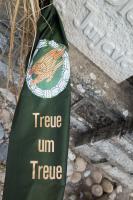
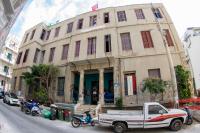
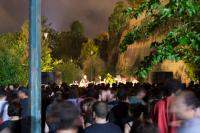
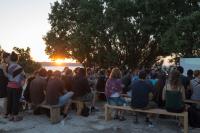
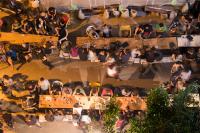
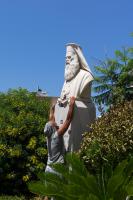
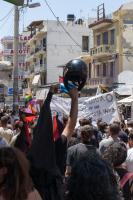
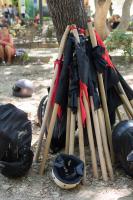
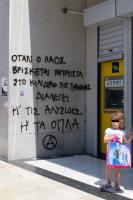


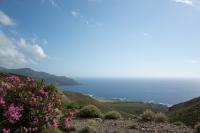
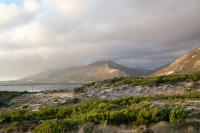
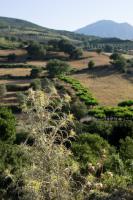
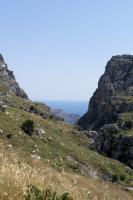
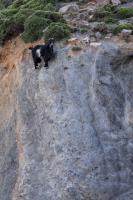
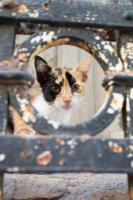
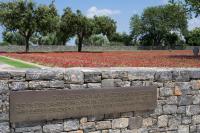
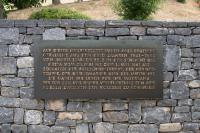

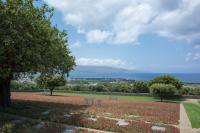
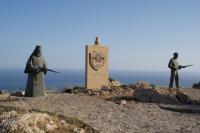

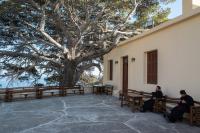
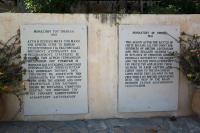
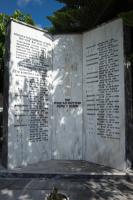
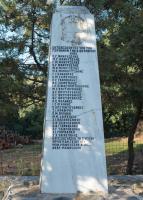
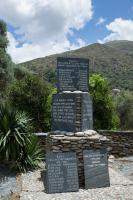
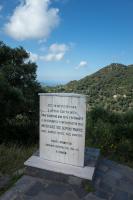
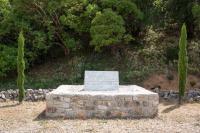
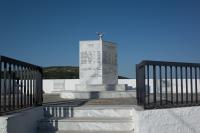
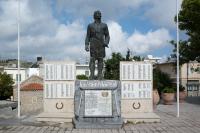
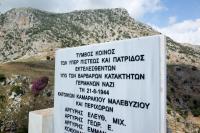

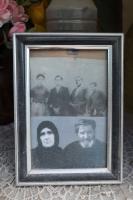
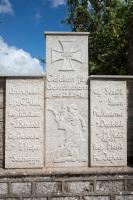
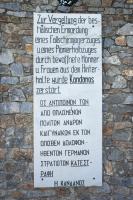
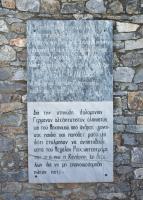
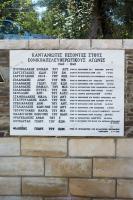
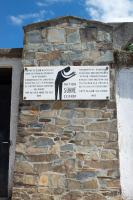
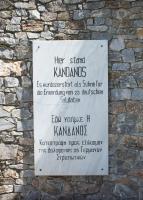
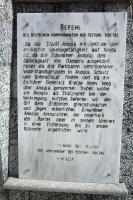
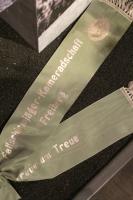
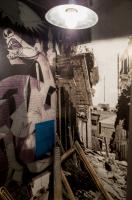
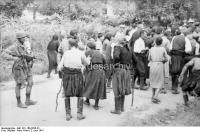
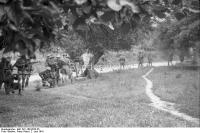

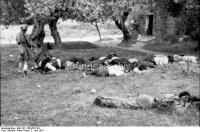
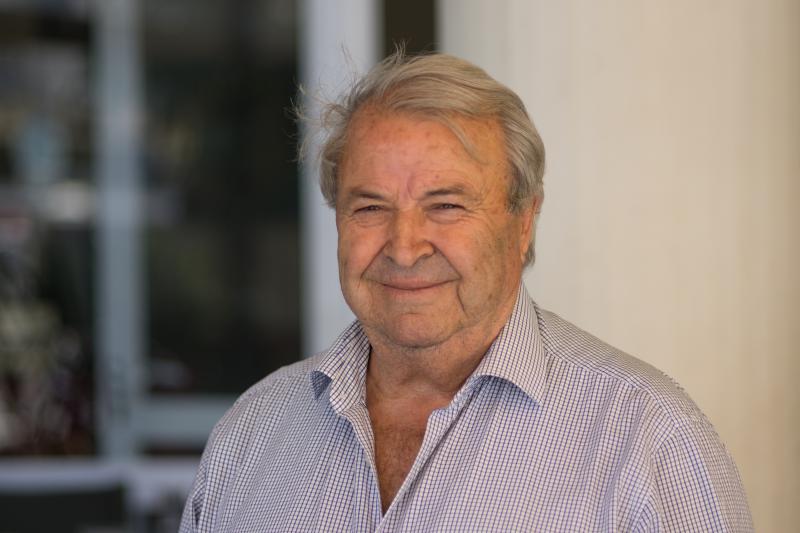


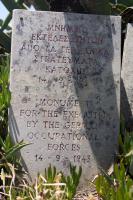
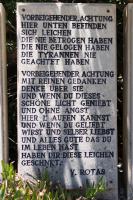
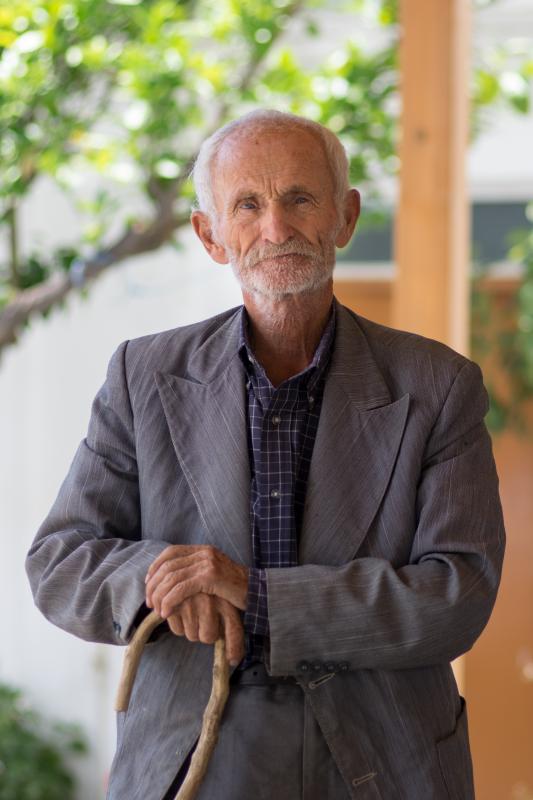
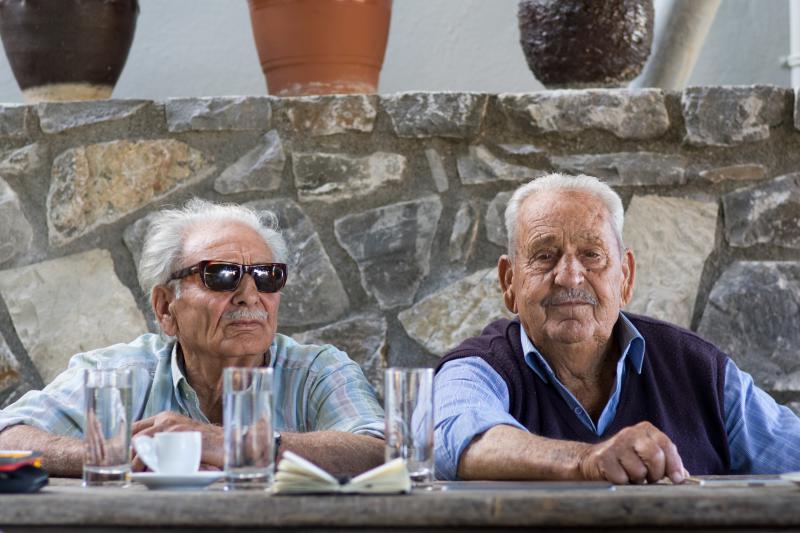
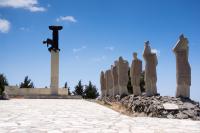

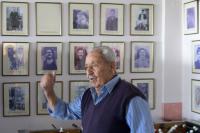
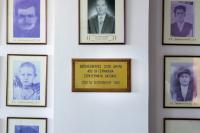
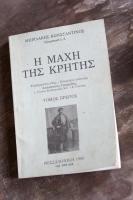
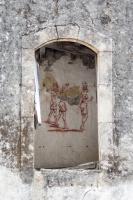
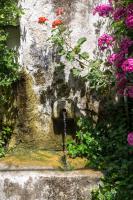
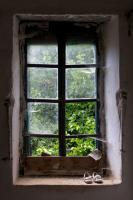
Remember and fight!
Thank you very much for this article. It is a shame that there are still German people who think the Nazi invasion was honorable. It fills me with anger that these monuments like that shameful eagle in Chania still stand. It is a reminder that there is still a lot of work to do until the Germans and their government will accept the fact that there is a lot to compensate - last but not least financial!
Let's keep up the struggle both in Greece and in Germany!
Greetings to all Cretan antifascists!